 | Adiyaman Oil Field – near Samosata, part of Armenia's Versailles 1919 claim. Located north of Urfa, south of Malatya, east of Marash and west of Diyarbekir. Known as a Hellenized Armenian kingdom of Commagene and a seat of the Yervanduni dynasty. Part of Kharpert Villayet, where there a number of Armenian villages and church properties, including Holy Savior Church/Monastery. The oil field is operated by the state-owned Turkish Petroleum Corporation and accounts for 27% of Turkey's Oil production. It was developed with California Asiatic Oil and Texaco Overseas Petroleum starting the 1960 72 million barrels reserve. |
 | Afsin Coal Field – 40% of the Ccoal production in Turkey. In Marash province, north of Zeytun, south of Gorun, Doğan Holding, Doğuş Holding, Unit Investment (BELGIUM) and Anadolu Group, produced 5 tonnes of coal annually; important for Turkish Energy Production, Elektrik Uretim AS produced 42,8% of Turkey's electricity. UAE, Qatar, Unit Investment (Belgium), GHD (Australia) provided mine engineering assistance. |
 | Aladag – Adana, Chromium Mine, owned by Eti Maden, (Parent - Savings Deposit Insurance Fund of Turkey) has a reserve 200 million tonnes, located in Adana province, not far from the medieval Armenian monastic complex of Akner, built by King Levon II in the 12-13th century. |
 | Avnik, Iron mine, owned by Eti Maden (Parent - Savings Deposit Insurance Fund of Turkey) the largest iron reserve in Turkey with estimated reserves of 43.7 million tonnes of iron metal, located in Bingöl (Armenian: Ճապաղջուր, Chapakchur), part of Greater Hayk since the pre-Christian era, part of Diarbekir (and later Bitlis provinces). |
 | Batman Oil Field southeast of Tigranakert, owned by the Turkish Petroleum Corporation. First exploited in 1950s, 8.9 million barrels of crude oil and 10.6 million sm3 natural gas were produced in 2014. It accounts for more than 50% of Turkey’s oil production, large refinery since the 1950s. An area of Neolithic settlement, historical record since 7th cent. BC, part of the as a province of Armenia in Alexander the Great's time, and thereafter in Byzantine times, through the 20th century, part of Diarbekir Villayet. |
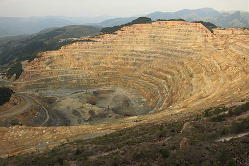 | Çakmakkaya, Copper mine owned by, Eti Maden, Parent - Savings Deposit Insurance Fund of Turkey, in Ardvin, one of the largest copper reserves in Turkey, with over 800,000 tonnes of copper. |
| Cayeli Bakır İşletmeleri, Çayeli Copper, Zinc mine on the Black Sea Coast, near Trebizond in Rize, considered as an outlet to the sea for Armenia during the Paris Peace Conference post-WWI. 1.2 million tonnes, annual production; developed with Phelps Dodge in the 1950s, later international investment through Inmet Mining Corporation (CANADA) and First Quantum Minerals Ltd (CANADA). One of Turkey's largest companies traded on the Toronto Stock Exchange. |
 | Cevizlidere Copper Mine, in Tunceli, 445 million tones in reserves, north of Elazig, south of Erzincan. One of the largest copper mines in Turkey. In the north of Mamuretulaziz, part of Dersim region, not far from Chemishgezek. Owned by Alacer Gold Corporation (USA). |
 | Çöpler Gold Mine, owned by Alacer Gold, with estimated reserves of 6 million oz. of gold, located south-west of Erzincan, (Armenian Երզնկա Yerznka), an ancient Armenian city, Acilisene, where in 387 AD Armenia was divided between the Byzantine and Persian Empires. There are references to a pre-Christian cult center of the goddess Anahit in the city and it is mentioned by Koriwn as Yekghiats, in his biography of Mashtots. The region had a majority Armenian population, 11 monasteries and 33 churches. |
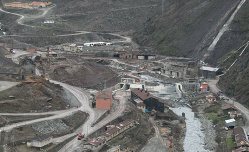 | Damar, Copper Mine, owned by Eti Maden (Parent - Savings Deposit Insurance Fund of Turkey) in Ardvin, 167,000 tonnes of copper metal. |
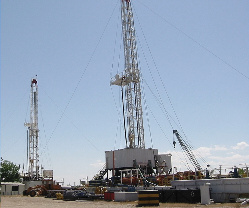 | Diyarbakır Oil Field, owned and developed in 2009 by Turkish Petroleum Company, has proven reserves of 16 million barrels, with production of 250 barrels a day. Diyarbakir, is Armenian Tigranakert, capital of the pre-Christian Armenian empire of Tigran the Great, and a See of the Armenian church. The ethnic cleansing of the indigenous Armenian and Assyrian population, reached a turning point in 1895, when more than 150,000 were deported. St. Giragos Church, the largest in the region, was restored and reopened in 2011. |
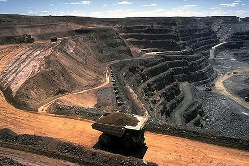 | Hasancelebi Iron Mine, owned by Eti Maden (Parent - Savings Deposit Insurance Fund of Turkey), as the largest iron reserve in Turkey, with more than 10.8 million tonnes of iron metal, located in Malatya Province. Malatya (Classical Melitene), a center of Armenian culture in Armenia Minor, was reported by the Roman historian Procopius to have had many temples, agoras and theatres, no trace of which is left today. In the middle ages, the city had a population of over 60,000. The city had a large Armenian population (est. 20,000) which was ethnically cleansed during the 1895-1896 Hamidian massacres and later the Armenian Genocide. Of the five churches in the city, three belonged to the Armenian Church. It was also an episcopal see of the Armenian church for a period, had a large monastery dedicated to St. Gregory the Illuminator, and a number of Armenian school. |
 | Mardin Phosphate Mine, owned by Eti Maden (Parent - Savings Deposit Insurance Fund of Turkey), in southeast Turkey, one of the largest phosphate reserves in Turkey, with over 200 million tonnes of ore (grade 11%). Mardin is an ancient Armenian city and episcopal see of the Armenian and Assyrian Churches. It was ethnically cleans during the Armenian Genocide of both the Armenian and Assyrian populations, which numbered nearly 20,000. St. Gregory the Illuminator church was founded in Mardin in 420. |
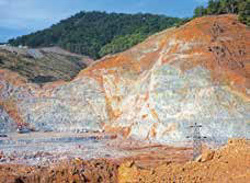 | Mollakara, Gold Mine north of Van, in Aghbi, Agri Province, operated by, KOZA ALTIN İŞLETMELERİ A.Ş. Total Proven and Probable Reserve 59,954 kilotonnes of ore. Near Gharakilisa, which refers to a 17th cent. Armenian church, in an area inhabited by Armenians since the Urartian period, known as Tariuni (Daroynk'), an Armenian fortress city that withstood Sasanian invasion in the 4th century and became a Bagratuni stronghold and royal treasury, later known as Old Bayazet. |
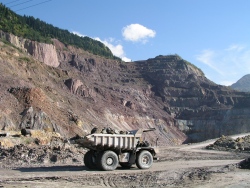 | Murgul, Copper Mine, owned by Eti Maden IGM, a Turkish state-owned mining and chemicals company, (parent - Savings Deposit Insurance Fund of Turkey), in Ardvin, located 30 km from the Black Sea, part of Russian Armenian Provinces until WWI, has 40 million tonnes of copper ore (reserve), one of the largest copper mines in Turkey. Ardvin city was 76.4%, according the 1897 census, but the countryside was largely Turkish. The region has a long Armenian history, particularly in Bagratuni period (9th-11th centuries) and had 5 large churches and a school. |
_and_Armenians_in_early_21st_century.png)